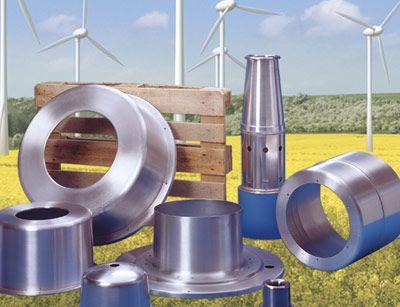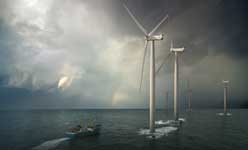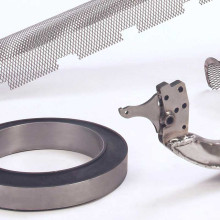In metal spinning and thermoforming produced Blechformteile for wind power
- Details
- Hits: 6782

In all branches of the supply industry, the efficiency requirements of the wind energy industry promote the innovative strength of companies. This not only applies to the manufacture of rotors, drives, bearings and controls, but also to the area of shaped sheet metal parts. The supplier Rübsamen, for example, uses two forming processes to manufacture highly resilient precision components for onshore and offshore technology. The company has adjusted to the demands of wind turbine manufacturers for small and medium-sized quantities.
No matter whether on- or offshore technology: the wind power industry is characterized by continued strong growth. In 2014 alone, 400 new wind turbines were connected to the grid, and soon almost 10% of German electricity will be generated by wind power technology - with an upward trend. Due to its ability to manufacture high-quality sheet metal parts very economically, even in small to medium batch sizes, the sheet metal parts supplier also benefits from this. With its high degree of specialization in the two metal forming and deep-drawing processes, it can fully meet this desire of plant manufacturers in the wind power industry. For example, the company is currently supplying its wind turbine customers with many ready-to-install sheet metal parts made of high-quality steel grades, aluminum alloys and non-ferrous metal alloys.
Produce steel without thermal stress
 Numerous plant manufacturers in the onshore and offshore industry not only have large, thin-walled housing components manufactured, but sometimes also very thick-walled molded parts. A typical example of this is a solid steel abutment for holding rubber elements that are installed in wind turbines to dampen vibrations.
Numerous plant manufacturers in the onshore and offshore industry not only have large, thin-walled housing components manufactured, but sometimes also very thick-walled molded parts. A typical example of this is a solid steel abutment for holding rubber elements that are installed in wind turbines to dampen vibrations.
The realized high-strength steel part measures 240 x 190 mm and has a wall thickness of 7,5 mm. Its geometry is characterized by a mounting plate drilled four times, from which a cone with a basic conical shape protrudes. The rubber element will later be stored in this cone. The decisive aspect for the customer: The supplier can use the metal spinning technique to produce the complete abutment in one piece and without major thermal stress for the steel structure. In this way, the plant manufacturer receives a highly resilient quality component "Made in Germany".
Metal spinning is a cold forming process, sometimes also known as extrusion. It is very raw material saving and does not require expensive mold tools. In many cases, it therefore proves to be extremely energy-efficient and economical - especially when small to medium-sized quantities are required. In addition, metal spinning scores in the production of rotationally symmetrical components that can be produced without any seams and have very good strength values.
 Couplings, brakes and monitoring for the wind turbine
Couplings, brakes and monitoring for the wind turbine
If larger quantities of up to 100.000 are to be produced or if the component geometry precludes the use of metal spinning, the manufacturer switches to deep drawing in accordance with DIN 8584. In its modern press park, the company then produces formed parts with diameters of 20 to 2000 mm, edge lengths of 2000 x 1500 mm and wall thicknesses of 0,5 to 15 mm.
High flexibility thanks to process diversity
In addition to modern laser cutting systems and CNC metal centering presses, numerous deep drawing machines with up to 600 t pressing force are in operation in the machine park. In addition, the company covers many subsequent process stages with other processing methods - from embossing, punching and punching to surface technology. In recent years, the competencies in assembly manufacturing (stainless steel, steel, aluminum) have also been greatly expanded. For this purpose, the supplier not only uses its own 3D design and in-house toolmaking, but also its meanwhile considerable capacities in automated welding. Here, in addition to the flash butt and projection welding process, he also uses laser and MIG / MAG welding.Helmut Rübsamen is certified according to DIN ISO 9001 and approved as welder specialist. The company is therefore also recognized as a partner for the manufacture of safety-relevant components. Among others, 3D measurement technology and automated balancing technology are used for quality assurance.
You might also be interested in...

